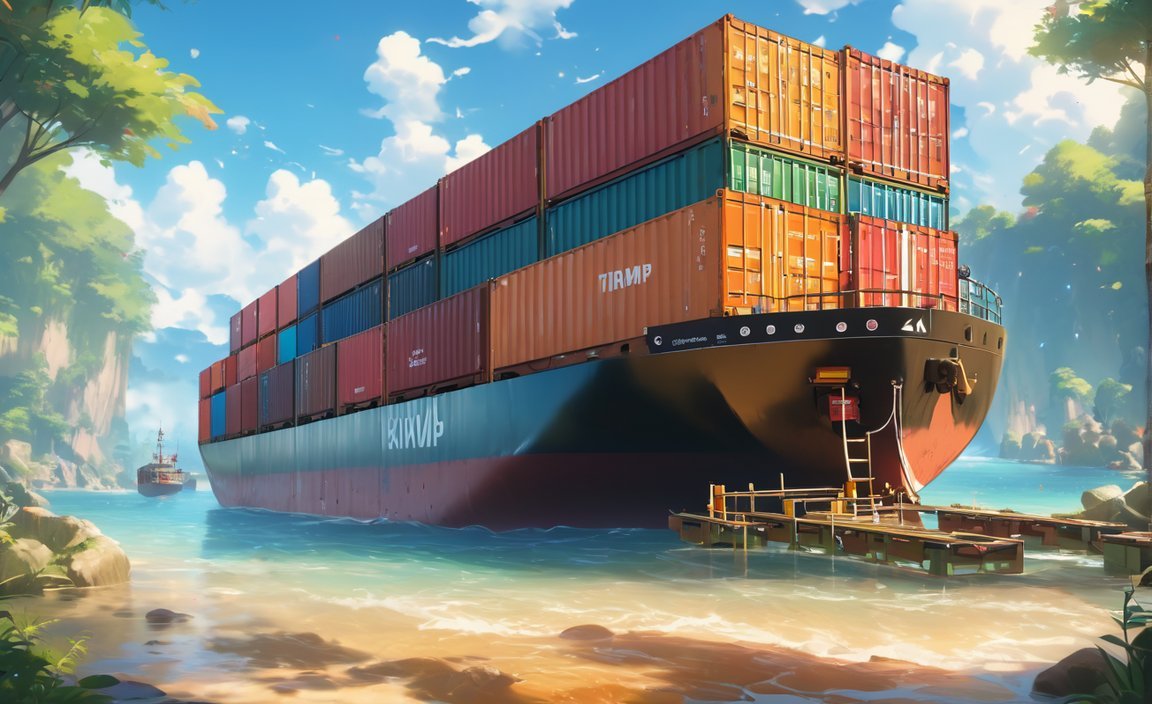Tramp shipping, a niche within the ever-expanding global shipping industry, presents both advantages and disadvantages that businesses and logistics professionals must carefully consider. In this comprehensive analysis, we delve into the pros and cons of tramp shipping, offering valuable insights into its strengths and weaknesses. From flexibility and availability of capacity to cost-saving potentials, tramp shipping certainly has its benefits. However, it also faces challenges such as market volatility, limited contract terms, and a lack of schedule reliability. Join us as we explore the complexities of tramp shipping and provide an objective perspective on this fascinating aspect of international logistics.
Key Takeaways:
– Liner services have fixed shipping timetables, while tramp services have no fixed schedule or route and are usually slower.
– Liners carry cargo from a large number of shippers, while tramps carry cargo from one or a few shippers.
– Liner services offer predictability and efficiency in port operations and cargo handling, while tramp services offer flexibility and the ability to serve various markets.
– Liner services have fixed freight rates, while tramp services require negotiated rates for each shipment.
– Tramp shipping may be perceived as unstable and unorganized, but it can attract fixed clients with lower rates.
– Liner services are associated with container cargo and various types of cargo, while tramp ships are relied upon to service any market.
Advantages and Disadvantages of Tramp Shipping

Tramp shipping, unlike its counterpart liner services, offers a different approach to cargo transportation with its unique advantages and disadvantages. In this article, we will delve into the pros and cons of tramp shipping, providing a comprehensive analysis of this flexible yet unpredictable mode of transportation.
The Advantages:
Flexibility and Capacity Availability: Tramp ships are known for their flexibility to serve various markets at a moment’s notice. Unlike liner services that follow fixed timetables and routes, tramp services are not constrained by rigid schedules. This allows for greater adaptability to changing market demands and the ability to transport different types of cargo.
Cost-Saving Potential: Tramp shipping can offer cost-saving advantages for shippers. As tramp services do not have fixed freight rates like liner services, rates can be negotiated for each shipment based on market conditions and demand. This provides an opportunity for shippers to secure more budget-friendly rates, especially during periods of decreased demand when tramp ships may be underutilized.
Versatility in Servicing Multiple Markets: Tramp ships are relied upon to service any type of market. While liner services cater to a large number of shippers, tramp ships often carry cargo from one or a few shippers. This allows tramp services to offer personalized attention to specific clients, addressing their unique needs and requirements.
The Disadvantages:
Market Volatility and Uncertainty: One of the main challenges associated with tramp shipping is its susceptibility to market volatility. The lack of fixed schedules and routes makes tramp services more vulnerable to economic fluctuations and changes in demand. Shippers relying on tramp shipping should be prepared for potential delays and uncertainties.
Limited Contract Terms: Tramp shipping typically involves shorter-term contracts compared to liner services. Shippers may face difficulties securing long-term commitments from tramp ship operators due to the unpredictable nature of their services. This can result in potential disruptions to supply chains and logistics planning.
Reduced Schedule Reliability: Unlike liner services that adhere to fixed timetables, tramp ships often operate at a slower pace and lack schedule reliability. This can pose challenges for shippers requiring time-sensitive deliveries or those with strict logistics timelines. It is essential for shippers to carefully assess their requirements and consider alternative options when timing is crucial.
Summary:
Tramp shipping offers unique advantages such as flexibility, capacity availability, and cost-saving potential. It is a viable option for shippers needing personalized attention and adaptability to changing market demands. However, it is important to consider the potential challenges of market volatility, limited contract terms, and reduced schedule reliability associated with tramp shipping. Shippers must carefully evaluate their needs and consider the specific advantages and disadvantages of tramp shipping before making transportation decisions.
Overall, tramp shipping presents a valuable alternative in the realm of cargo transportation, offering a flexible solution with the potential for cost savings. By understanding the advantages and disadvantages outlined in this article, shippers can make informed decisions to optimize their supply chain and achieve their transportation goals.
Interested in learning about the advantages and disadvantages of intelligent transport systems? Check out our detailed analysis here to gain valuable insights into this innovative technology.
Looking to understand the benefits and drawbacks of transportation management systems? Explore our comprehensive guide here and discover how this system can streamline your transportation processes.
Cost-saving Potential

Tramp shipping offers various advantages and disadvantages for shippers. One of the key advantages is the cost-saving potential that it provides. Let’s take a closer look at how tramp shipping can help businesses save costs in their transportation operations.
Benefits of Tramp Shipping: Cost-saving Potential
Tramp shipping can be a cost-effective option for shippers due to its flexible nature and capacity availability. Here are some ways in which tramp shipping can lead to cost savings:
1. Competitive Pricing: Tramp shipping often involves negotiating freight rates directly with ship owners or charterers. This allows shippers to have more control over the pricing and potentially secure more competitive rates compared to fixed-priced liner services. By exploring different options and selecting the most cost-effective solution, businesses can save significantly on their shipping expenses.
2. Optimization of Cargo: Tramp shipping offers the advantage of flexibility, allowing shippers to optimize their cargo loads. Unlike liner services that follow fixed routes and schedules, tramp services can cater to specific cargo needs. This means shippers can consolidate loads, increase cargo volume, or adjust shipments according to demand, thereby reducing the average cost per unit transported. By utilizing the available space efficiently, businesses can achieve cost savings in their shipping operations.
3. Avoidance of Demurrage Fees: With tramp shipping, shippers have more control over the vessels and their timelines. This reduces the risk of delays and potential demurrage fees. Demurrage fees are penalties that shippers have to pay to ship owners if the cargo remains on the ship for longer than the agreed-upon time. By choosing tramp shipping and carefully planning the transportation process, businesses can avoid unnecessary costs associated with demurrage fees.
4. Flexibility in Route Planning: Tramp services provide the flexibility to choose the most optimal routes based on market conditions, port congestion, or any other factors that may impact the transportation process. By strategically planning the routes, shippers can reduce transit times, optimize fuel consumption, and minimize additional costs that may arise due to unexpected delays or disruptions. This proactive approach to route planning can result in significant cost savings for businesses.
Considering the cost-saving potential of tramp shipping, it is important for shippers to carefully evaluate their specific needs and weigh the advantages and disadvantages. While tramp shipping offers opportunities for significant cost savings, it is essential to consider potential challenges such as market volatility, limited contract terms, and reduced schedule reliability. By conducting thorough analysis and utilizing the expertise of transportation professionals, businesses can make informed decisions to optimize their shipping operations and achieve cost efficiencies.
Key Takeaways:
– Tramp shipping provides opportunities for cost savings due to its competitive pricing and flexibility in cargo optimization.
– Shippers can avoid demurrage fees by having more control over vessel timelines.
– Flexible route planning in tramp shipping allows for more efficient transportation, reducing additional costs.
– It is important to carefully evaluate the advantages and disadvantages of tramp shipping, considering market volatility, limited contract terms, and reduced schedule reliability.
Citation(s):
– Marine Insight – What Are Liner Services and Tramp Shipping?
– A One Maritime – What is Tramp Shipping or chartering?
Market Volatility as a Challenge
Market volatility poses a significant challenge in the tramp shipping industry. Tramp ships, known for their flexibility and capacity availability, operate in a market driven by demand and supply. While this provides advantages in servicing multiple markets, it also exposes tramp shipping to the unpredictability of market conditions, resulting in market volatility.
Market volatility refers to the rapid and significant fluctuations in freight rates, vessel availability, and cargo demand. These fluctuations can be influenced by various factors, including global economic conditions, political instability, natural disasters, and changes in trade patterns. The impact of market volatility can be felt throughout the tramp shipping industry, affecting ship owners, charterers, and freight rates.
One of the main challenges of market volatility in tramp shipping is the uncertainty it brings. Fluctuating freight rates can make it difficult for both shippers and service providers to predict and plan for shipping costs. The lack of price stability can lead to financial uncertainty and make it challenging to manage budgets and logistics operations effectively.
Additionally, market volatility in tramp shipping can result in limited contract terms. Unlike liner services that operate on fixed schedules and long-term contracts, tramp shipping relies heavily on short-term charter contracts. These contracts are often subject to renegotiation based on market conditions, making it challenging for shippers to secure long-term agreements that provide stability.
Another issue arising from market volatility is the reduced schedule reliability. Tramp ships do not adhere to fixed schedules and trade on the spot market. During times of high market volatility, the availability of tramp ships may be limited, causing delays in the transportation of goods. This reduced schedule reliability can disrupt supply chains and lead to additional costs for shippers.
To navigate the challenges posed by market volatility in tramp shipping, shippers should carefully evaluate their needs and consider the advantages and disadvantages. It is essential to assess the level of flexibility required, the sensitivity to cost fluctuations, and the tolerance for potential delays. Shippers can also explore risk management strategies, such as hedging freight rates or establishing contingency plans.
While market volatility presents challenges, it is crucial to note that tramp shipping still offers significant advantages, including flexibility, capacity availability, and cost-saving potential. By understanding the potential risks and leveraging the benefits, shippers can make informed decisions and navigate the dynamic tramp shipping market successfully.
Key Takeaways:
- Market volatility poses a significant challenge in the tramp shipping industry.
- It brings uncertainty, making it difficult to predict and plan shipping costs.
- Limited contract terms can result from market volatility, affecting long-term agreements.
- Reduced schedule reliability is another issue caused by market volatility.
- Shippers need to carefully evaluate their needs and consider the advantages and disadvantages of tramp shipping.
- Risk management strategies can help mitigate the impact of market volatility.
- Tramp shipping still offers advantages, including flexibility, capacity availability, and cost-saving potential.
Sources:
– Vinh V. Thai, Wei Jun Tay, Raymond Tan, Alan Lai. (2014). Defining Service Quality in Tramp Shipping: Conceptual Model and… ScienceDirect
– Evolved Trader. (2022). Breaking Down the Pros & Cons of Volatility. Evolved Trader
Limited Contract Terms as a Disadvantage
As we delve into the advantages and disadvantages of tramp shipping, one significant disadvantage that emerges is the limited contract terms associated with this mode of transportation. Tramp shipping, known for its flexibility and adaptability, operates on short notice and does not follow a strict schedule or route. While this can offer certain advantages, it also introduces challenges that shippers should consider.
1. Negotiating Limited Contract Terms
In tramp shipping, the lack of fixed schedules and routes means that contracts are typically shorter in duration compared to liner shipping. Limited contract terms can pose difficulties for both shippers and carriers. Shippers may have to renegotiate contracts frequently, which can result in increased administrative work and uncertainty. On the other hand, carriers may face difficulties in securing long-term commitments, affecting their revenue stability and financial planning.
2. Implications for Stability and Financial Predictability
Long-term contracts in liner shipping provide stability and financial predictability for agencies. By having set schedules and routes, liner services offer a higher degree of certainty for shippers. However, for tramp shipping, the absence of fixed schedules and routes means that long-term contracts are less common. This lack of stability can make it challenging for shippers to plan their supply chains effectively. Additionally, the absence of long-term contracts reduces the opportunity for the development of meaningful client relationships.
3. Associated Market Risks
The tramp shipping market is characterized by its volatility and uncertainty. Frequent fluctuations in demand and supply can result in price fluctuations, making it challenging for shippers to secure favorable rates and long-term agreements. Whereas liner services offer predictability through fixed schedules and contracted cargo volumes, tramp shipping relies heavily on market conditions, which can impact pricing and availability. This market volatility adds another layer of risk to tramp shipping, making it necessary for shippers to carefully evaluate their options.
Key Takeaways:
– Limited contract terms in tramp shipping can pose challenges for both shippers and carriers, requiring frequent renegotiations and introducing uncertainty.
– The absence of fixed schedules and routes in tramp shipping reduces stability and financial predictability compared to liner shipping.
– Tramp shipping is subject to market volatility and uncertainty, which can impact pricing and availability.
– Shippers should weigh the advantages and disadvantages before choosing tramp shipping, considering their specific needs and risk tolerance.
Sources:
– Qafila: What is the Difference between a Liner and Tramp Service?
– NI Business Info: Advantages and disadvantages of sea transport for international trade
FAQ
Q1: What are the advantages of tramp shipping?
A1: Tramp shipping offers advantages such as flexibility, as it allows for shipments to be arranged on short notice. It also provides the ability to negotiate prices for each shipment, potentially saving costs compared to fixed freight rates in liner shipping.
Q2: What are the disadvantages of tramp shipping?
A2: Tramp shipping has potential disadvantages such as higher costs compared to liner shipping, as negotiated rates may not always be as competitive. Additionally, tramp services are generally slower than liner services, which could result in longer transit times for cargo.
Q3: What is the main difference between liner shipping and tramp shipping?
A3: The main difference between liner shipping and tramp shipping lies in the cargo they carry. Liners carry cargo from a large number of shippers, whereas tramps carry cargo from one or a few shippers. Additionally, liner services have fixed schedules and routes, while tramp services do not follow a fixed schedule or route.
Q4: Can tramp shipping cater to specific cargo needs?
A4: Yes, tramp shipping offers the advantage of being able to cater to specific cargo needs. Since tramps operate on short notice and negotiate prices for each shipment, they can accommodate unique shipping requirements that may not be suitable for regular liner services.
Q5: Are tramp services more susceptible to market volatility?
A5: Tramp services are typically more exposed to market volatility compared to liner services. The fluctuating demand and supply in the tramp shipping market can impact freight rates and availability of vessels. Shippers considering tramp shipping should be aware of the potential risks and uncertainties associated with market conditions.
















